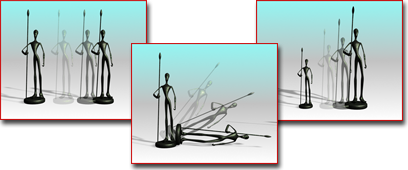A transform is an adjustment of an object’s position, orientation, or scale, relative to the 3D world (or world space) in which you’re working.

Changing a model by changing its position, rotation, or scale
You can apply three types of transform to an object:
This section presents these brief topics designed to help you quickly start learning how to transform objects, and how to animate your transforms:
Specifying a Reference Coordinate System
In some cases, an object might fail to move or rotate, even when the proper button is on and the object is selected. This could be due to one of the following reasons:
To transform an object using the main toolbar:
 (Select And Move),
(Select And Move),  (Select And Rotate), or
(Select And Rotate), or  (Select And Uniform Scale). These buttons are usually referred to as Move, Rotate, and Scale.
(Select And Uniform Scale). These buttons are usually referred to as Move, Rotate, and Scale.
If you drag the mouse over an unselected object, it becomes selected and is also transformed.
You can restrict transforms to one or two axes easily with the Using Transform Gizmos.
To transform an object from the quad menu:
To use the Transform Type-In dialog:
 Transform Type-In to display the dialog.
Transform Type-In to display the dialog.
For example, if Move is active, the dialog fields read out both the absolute and offset positions of the selected object in world space. If no object is selected, the fields turn gray.
To use transform type-in on the status bar:
 Absolute/Offset toggle, to the right of the X, Y, and Z fields, lets you switch between entering values that are absolute
(in world space) or offset (relative to the selection's present position, orientation, and dimensions).
Absolute/Offset toggle, to the right of the X, Y, and Z fields, lets you switch between entering values that are absolute
(in world space) or offset (relative to the selection's present position, orientation, and dimensions).
The Transform gizmos are viewport icons that let you quickly choose one or two axes when transforming a selection with the mouse.
Transform Type-In is a dialog that lets you enter precise values for move, rotate, and scale transforms. You can use Transform Type-In with anything that can display an axis tripod or Transform gizmo.
You can animate changes in position, rotation, and scale (transforms) by turning on the Auto Key button and then performing the transform at any frame other than frame 0. This creates a key for that transform at the current frame.
3ds Max provides three controls, collectively referred to as the transform managers, for modifying the action of the transform tools.
The reference coordinate system determines the orientation of the X, Y, and Z axes used by the transform. The type of transform system you use affects all transform operations.
The transform center affects scale and rotation transforms, but has no effect on position transforms.
The Restrict to ... buttons, also called the Axis Constraint buttons, are located on the Axis Constraints toolbar, which is off by default.
Use the Reset XForm (Transform) utility to push object rotation and scaling values onto the modifier stack and align object pivot points and bounding boxes with the World coordinate system. Reset XForm removes all Rotation and Scale values from selected objects and places those transforms in an XForm modifier.